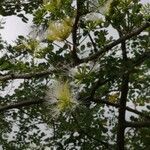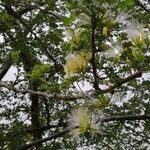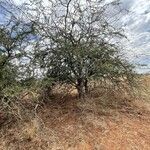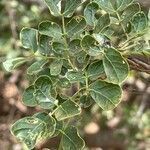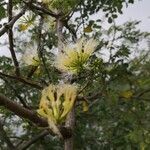Bush or tree 3–9(–12) m. high, deciduous; bark smooth, grey to brown.. Young branchlets glabrous or sometimes shortly pubescent; twigs often with short divaricate lateral branches.. Leaves: rhachides of leaves and pinnae glabrous to shortly pubescent, in all or most leaves projecting at ends in a short rigid persistent deflexed or downwards-bent hook or claw; often a single stipel similarly bent near base of pinnae; pinnae 1–2(–4) pairs; leaflets 1–4(–5) pairs, obliquely obovate to suborbicular, (7–)10–36 (–42) mm. long, (4–)6–31 mm. wide, mucronate at apex, venose, glabrous to ± sparsely shortly pubescent.. Flowers usually on leafless twigs, on pedicels 0.5–5.5 mm. long.. Calyx pale greenish, (very rarely 2–)3–5 mm. long, glabrous to sparsely finely pubescent outside, irregularly denticulate at apex and usually slit unilaterally to about 1–2.5 mm.. Corolla pale greenish, 6–12 mm. long, glabrous, or puberulous on and near lobe-margins.. Staminal tube not or scarcely exserted beyond corolla; filaments about 1.5–2 cm. long, white.. Pod oblong, 7–18 cm. long, 1.5–2.9 cm. wide, quite glabrous or occasionally puberulous all over, straw-coloured.. Seeds 9–13 mm. in diameter, flattened, round.
A shrub or tree. It grows 2-9 m high. The bark is smooth and grey. The young branches are smooth but can sometimes have a few soft hairs. There is usually a bent hook ate the end of most leaves. The leaves are compound. There are 1-4 pairs of leaflets along 1 or 2 leaflet stalks. The leaflets are 1-4 cm long by 1-3 cm wide. The flowers are usually on leafless twigs. They are green. The fruit are pods 7-18 cm long by 1-3 cm wide. They are straw coloured when mature. The seeds are about 1 cm across and round and flattened.
Leaves: rhachides of leaves and pinnae glabrous to shortly pubescent, in all or most leaves projecting at the ends in a short rigid persistent deflexed or downwards-bent hook or claw; often a single stipel similarly bent near the base of the pinnae; pinnae 1-2(4) pairs; leaflets 1-4(5) pairs (7)10-36(42) x (4)6-31 mm., obliquely obovate or elliptic to subcircular, mucronate at the apex, venose, glabrous to ± sparsely shortly pubescent.
Shrub or tree, up to 10 m high. Young branchlets often forming abbreviated spine-tipped lateral shoots. Leaflets 2-4 pairs per pinna; rhachides and rhachillae of all or most leaves projecting at ends as short rigid persistent deflexed hook. Flowers white.
Bush or tree 2-9(12) m. high, deciduous; bark smooth, grey to brown; young branchlets glabrous or sometimes shortly pubescent; twigs often with short divaricate almost spinescent-tipped lateral branches.
Calyx pale-greenish, (very rarely 2)3-5 mm. long, glabrous to sparsely finely pubescent outside, irregularly denticulate at the apex and usually slit unilaterally to c. 1-2.5 mm.
Pod dehiscent, (6)7-18 x 1.5-2.9 cm., oblong, quite glabrous or occasionally puberulous all over, straw-coloured when mature.
Staminal tube not or scarcely exserted beyond the corolla; filaments c. 1.5-2.5 cm. long, white.
Corolla pale-greenish, 6-12 mm. long, glabrous, or puberulous on or near the lobe-margins.
Flowers usually on leafless twigs, on pedicels 0.5-5.5 mm. long.
Seeds 9-13 mm. in diam., flattened, round.
